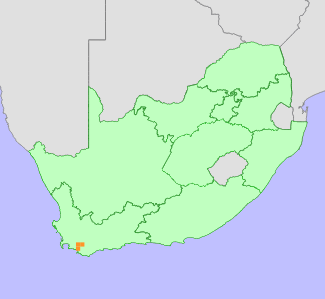|
Scientific Name | Aristea biflora Weim. |
Higher Classification | Monocotyledons |
Family | IRIDACEAE |
National Status |
Status and Criteria | Vulnerable B1ab(iii,v)+2ab(iii,v) |
Assessment Date | 2021/03/01 |
Assessor(s) | D. Raimondo & H. Mtshali |
Justification | An endemic species to Western Cape Province, with an extent of occurrence (EOO) of 23-77 km², and an area of occupancy (AOO) of 32-40 km². Over 70% of its habitat has been lost to wheat cultivation. It now occurs in isolated fragments and it is known from between seven and nine locations and is declining due to alien plant invasion, incorrect fire regimes and urban expansion around the towns of Caledon and Middleton. It is therefore assessed as Vulnerable under B criterion. |
Distribution |
Endemism | South African endemic |
Provincial distribution | Western Cape |
Range | This species is endemic to the Western Province, South Africa, where it occurs from Caledon to Drayton. |
Habitat and Ecology |
Major system | Terrestrial |
Major habitats | Western Ruens Shale Renosterveld, Greyton Shale Fynbos |
Description | It is found is southern slopes and low hills in fynbos-Renosterveld on loamy or gravely clay. |
Threats |
| This species' habitat has been fragmented through extensive past loss to wheat cultivation. A total of 72% of its habitat has been irreversibly modified. There has been further degradation of habitat due to invasive alien plants, with the subpopulations at the base of the Caledon Swartberg particularly impacted by invasive species. Urban expansion around the town of Caledon is an ongoing threat to this species as remaining habitat around the town belongs to the municipality who are under pressure to develop for low cost housing.
Irregular fire return intervals are a further threat. Due to all subpopulations only remaining in fragments, fire needs to be carefully managed as this species is dependent on fire for flowering. Some fragments are being burnt too frequently, e.g. the fragments within the town of Caledon and those close to Middleton, while others that occur on farms are not being burnt frequently enough. |
Population |
This species has lost the majority of its habitat to crop cultivation with between 7 and 9 subpopulations remaining in small isolated fragments.
The subpopulation between the hospital and the N2 was last recorded in 1995 and had between 100 and 250 mature individuals. There are no recent monitoring records and the subpopulation is suspected to have declined due to invasive alien plants spreading at this location.
There is a subpopulation that occurs on either side of the Caledon golf course, on the patch to the south there were 100 plants in a 1 ha patch in 2019, there are scattered low density aliens on the site. To the north of the golf course two small stands were recorded in 2005 and 2006. There are no recent monitoring records but the habitat is still extant. This location is threatened by urban expansion.
The subpopulation at Drayton Siding West side of gravel road crossing railway lines has been monitored since 1983 and is still extant with the most recent recording in 2019. This is a small remnant patch of renosterveld, with scattered alien plants.
The subpopulation at Roodebloem kloof Farm, mountain slope opposite to Drayton siding has between 500 and 1000 plants and is threatened by alien plants.
On farm Voorhede on N side of N2, a subpopulation was recorded in 2010 there is no information on the size of the subpopulation.
The subpopulation on the east end of Swartberg on Farm Boven Speelmansrivier was recorded as locally abundant in 1997 and there is still habitat available.
There is a small subpopulation of 200-500 at the Wirbank uitspanning and railway sidings in a fragment of vegetation that is 700 m long and 50 m wide.
There are two subpopulations which may be extinct one on the western side of the Caledon Swartberg and an old record from the north side of Shaws Pass.
This species has lost extensive habitat with six historic site no longer extant.
|
Population trend | Decreasing |
Notes |
| It is a fire-dependent species and needs fire to germinate. Therefore, most flowers are present in the first year after a burn. |
Assessment History |
Taxon assessed |
Status and Criteria |
Citation/Red List version | | Aristea biflora Weim. | EN B1ab(iii,v)+2ab(iii,v) | Raimondo et al. (2009) | | Aristea biflora Weim. | Endangered | Hilton-Taylor (1996) | |
Bibliography |
Goldblatt, P. and Manning, J.C. 2000. Cape Plants: A conspectus of the Cape Flora of South Africa. Strelitzia 9. National Botanical Institute, Cape Town.
Goldblatt, P. and Manning, J.C. 2020. Iridaceae of southern Africa. Strelitzia 42. South African National Biodiversity Institute, Pretoria.
Hilton-Taylor, C. 1996. Red data list of southern African plants. Strelitzia 4. South African National Botanical Institute, Pretoria.
Manning, J., Goldblatt, P. and Snijman, D. 2002. The color encyclopedia of Cape bulbs. Timber Press, Portland/Cambridge.
Raimondo, D., von Staden, L., Foden, W., Victor, J.E., Helme, N.A., Turner, R.C., Kamundi, D.A. and Manyama, P.A. 2009. Red List of South African Plants. Strelitzia 25. South African National Biodiversity Institute, Pretoria.
|
Citation |
| Raimondo, D. & Mtshali, H. 2021. Aristea biflora Weim. National Assessment: Red List of South African Plants version 2024.1. Accessed on 2025/10/26 |
 Comment on this assessment
Comment on this assessment


